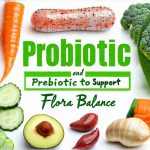Our digestive systems are incredibly complex ecosystems, teeming with trillions of microorganisms – bacteria, fungi, viruses, and others – collectively known as our gut microbiota. This intricate community plays a pivotal role not just in breaking down food, but also in nutrient absorption, immune function, mental wellbeing, and even chronic disease prevention. In recent years, there’s been growing recognition of the vital link between gut health and overall health, leading to increased interest in ways to support a balanced and thriving microbiome. While probiotic supplements are widely available, they can often be expensive and aren’t necessarily required for everyone. Many affordable and readily accessible food sources offer potent probiotic benefits, providing a natural and cost-effective way to nurture your digestive system.
This article will explore the fascinating world of food-based probiotics – how they work, which foods are richest in them, and practical strategies for incorporating them into your diet without breaking the bank. We’ll focus on demystifying the science behind fermentation, understanding the difference between probiotics and prebiotics, and offering tips to maximize probiotic benefits through mindful eating habits. The goal isn’t to replace medical advice or suggest a “cure-all,” but rather to empower you with knowledge and practical steps to improve your digestive wellbeing using accessible resources.
The Power of Fermentation: A Natural Probiotic Factory
Fermentation is an ancient food preservation technique that has been practiced for millennia across various cultures. It involves the metabolic processes of microorganisms, like bacteria or yeast, breaking down carbohydrates – sugars and starches – in a food. This process not only alters the taste, texture, and shelf life of foods but also creates probiotics as a natural byproduct. Think about how milk transforms into yogurt, cabbage becomes sauerkraut, or grapes turn into wine – all thanks to fermentation! The beauty of fermented foods is that they aren’t just delivering probiotics; they often contain a diverse range of strains, mimicking the complexity of a healthy gut microbiome more effectively than many single-strain supplements.
Fermented foods are also generally easier for our bodies to digest. The microorganisms pre-digest some of the components in the food, making them more accessible for nutrient absorption and reducing the burden on our digestive system. This can be particularly beneficial for individuals with sensitivities or digestive issues. It’s important to note that not all fermented foods are created equal; pasteurization – a process used to kill harmful bacteria – can also eliminate the beneficial probiotics. Therefore, look for unpasteurized versions whenever possible (and ensure they’ve been produced under safe conditions). Understanding how to reboot digestion can also help after periods where your diet hasn’t supported a healthy microbiome.
The process of fermentation isn’t just about adding good bacteria. It also produces postbiotics – metabolic byproducts created during fermentation that have their own health-promoting properties. These include short-chain fatty acids, vitamins, and enzymes which contribute to gut health and overall wellbeing. This makes fermented foods a truly holistic approach to digestive support.
Exploring Budget-Friendly Fermented Food Options
Many delicious and affordable fermented foods can easily be incorporated into your diet. Here are some accessible options:
- Yogurt: Plain, unsweetened yogurt (especially Greek yogurt) is an excellent source of Lactobacillus bacteria. Choose yogurts labeled “live and active cultures” to ensure they contain probiotics. A large tub of plain yogurt is often more cost-effective than individual servings, and you can add your own fruit or honey for flavor.
- Sauerkraut: Made from fermented cabbage, sauerkraut offers a tangy and crunchy addition to meals. It’s rich in Lactobacillus plantarum, known for its gut health benefits. Look for unpasteurized sauerkraut found in the refrigerated section of grocery stores.
- Kimchi: A staple in Korean cuisine, kimchi is made from fermented vegetables (typically cabbage and radish) with a spicy kick. It’s packed with various probiotic strains and offers a unique flavor profile. Like sauerkraut, opt for unpasteurized varieties.
- Kefir: Similar to yogurt but thinner in consistency, kefir is a fermented milk drink containing a wider range of probiotic strains than yogurt. You can find it plain or flavored (choose unsweetened options).
- Pickles (Fermented): Not all pickles are created equal! Many commercially available pickles are made using vinegar brining rather than fermentation. True fermented pickles will have a cloudier appearance and often contain live cultures. Check the label for “naturally fermented” or “lacto-fermented.” If you struggle with nausea, consider food and drink choices that are gentle on the stomach.
Homemade Fermentation: Taking Control & Saving Money
While purchasing pre-made fermented foods is convenient, making your own can be even more budget-friendly and allows you to control the ingredients and fermentation process. It’s surprisingly easy to get started!
1. Sauerkraut: Shred a cabbage, add salt (typically around 2% of the weight), and pack it tightly into a clean jar. Weigh down the cabbage with a glass or ceramic weight to keep it submerged in its own brine. Let it ferment for 7-21 days at room temperature.
2. Yogurt: You can make yogurt at home using just milk (dairy or non-dairy) and a starter culture (either store-bought yogurt with live cultures or a specialized yogurt starter). Heat the milk, cool slightly, add the starter, incubate for several hours, then refrigerate to stop fermentation.
3. Pickles: Combine water, salt, and spices (like dill and garlic). Submerge cucumbers in this brine and let them ferment for several days.
Homemade fermentation requires some initial investment in jars, weights, and potentially starters, but it quickly pays off in savings and gives you a rewarding culinary experience. There are countless resources online – blogs, videos, and books – to guide you through the process of making your own fermented foods safely and effectively. Learning to track nausea patterns can help you identify what triggers or helps with digestion.
Prebiotics: Fueling Your Probiotic Powerhouse
Probiotics need food too! Prebiotics are essentially fibers that act as nourishment for the beneficial bacteria in your gut. They aren’t living organisms like probiotics, but they play a crucial role in supporting probiotic activity and overall gut health. Combining probiotic-rich foods with prebiotic-rich foods is a powerful strategy for maximizing digestive benefits – it’s often referred to as “synbiotic” nutrition.
Many affordable and readily available foods are excellent sources of prebiotics:
* Onions & Garlic: These alliums contain inulin, a type of fiber that promotes the growth of Bifidobacteria.
* Bananas (slightly green): Green bananas contain resistant starch, which acts as a prebiotic.
* Oats: Oats are rich in beta-glucan, another beneficial prebiotic fiber.
* Apples: Contain pectin, a soluble fiber that supports gut health.
* Legumes (beans, lentils): Excellent sources of various prebiotic fibers.
Incorporating these foods into your daily diet alongside fermented foods creates a synergistic effect, providing both the probiotics and the fuel they need to thrive. This holistic approach is far more effective than simply taking probiotic supplements alone. If you’re following a specific diet, like vegan, ensuring adequate prebiotic intake is even more important. Keeping a symptom tracker can help you understand how different foods affect your digestion, and potentially identify sensitivities. And remember, it’s possible to eat for gut healing even on a budget!


















